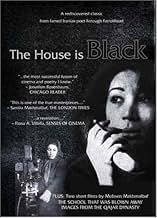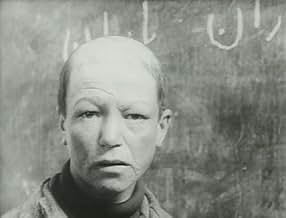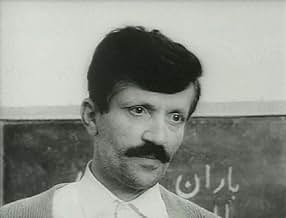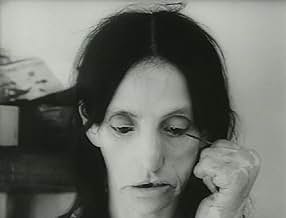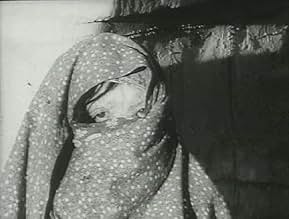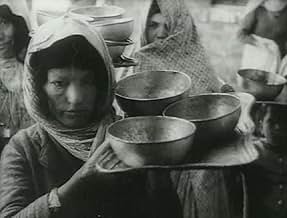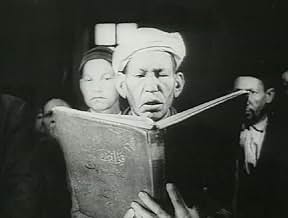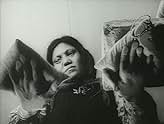Set in a leper colony in the north of Iran, The House is Black juxtaposes "ugliness", of which there is much in the world as stated in the opening scenes, with religion and gratitude.Set in a leper colony in the north of Iran, The House is Black juxtaposes "ugliness", of which there is much in the world as stated in the opening scenes, with religion and gratitude.Set in a leper colony in the north of Iran, The House is Black juxtaposes "ugliness", of which there is much in the world as stated in the opening scenes, with religion and gratitude.
- Director
- Writer
- Stars
Forugh Farrokhzad
- Narrator
- (uncredited)
Ebrahim Golestan
- Narrator
- (uncredited)
Hossein Mansouri
- Self
- (uncredited)
- Director
- Writer
- All cast & crew
- Production, box office & more at IMDbPro
Featured reviews
Quite surprising to see a documentary like this coming from the country Iran. You wouldn't think they would be too happy of showing leper patients and colonies to the entire world but yet this documentary managed to get made and released and is still globally considered to be an important one and is seen as the beginning of Iranian new wave.
It isn't really a documentary that tries to tell or story or gets a point across but it's more one that simply shows you things with its images. The visuals tell all you need to know. It shows the effects of leprosy on people of all ages and in all its various stages, also in its most gruesome and devastating forms.
It still does provide some information on the disease, to learn the Iranian people about it and make them aware of the decease and the fact that there are leper colonies in the country, in which people are living a normal as possible life and are also receiving treatment and going to school.
In that regard this is also somewhat of a more hopeful documentary, rather than a depressing one that shows you unhappy and incredibly sick or suffering people, who are waiting for their deaths. The documentary even makes it very clear that the decease is indeed curable and is not something that is inherited, so it's something that can be banned out completely with time, when taken the right precautions.
The hopefulness and thankfulness gets also illustrated by the many Koran lines that got put over the documentary and were delivered by the people with leprosy. In it they thank their God for everything they have. Or is there perhaps some reversed deeper meaning to it, trying to make a statement about the treatment of leper sufferers and the ruling power that puts them in these colonies. But this is something we often assume is the case with any movie/documentary coming out from a country that at the time suffers from an oppressing power or government. Perhaps we shouldn't read too much into it and simply appreciate the documentary for what it clearly is on its surface. Still the movie its very last shot makes me think it was a sort of a protest movie as well.
But even when you don't get that out of this documentary or don't want to read too much into things, you should be able than more to appreciate this documentary, since of the entire way it got shot and told. It has some great, beautiful, black & white cinematography, as well as a pleasant quick editing style and directing approach by female director Forugh Farrokhzad, who was better known as an important poet, during and after her lifetime, which ended abruptly in a road accident, only a couple of years after this movie.
An unique watch into a leper colony.
8/10
http://bobafett1138.blogspot.com/
It isn't really a documentary that tries to tell or story or gets a point across but it's more one that simply shows you things with its images. The visuals tell all you need to know. It shows the effects of leprosy on people of all ages and in all its various stages, also in its most gruesome and devastating forms.
It still does provide some information on the disease, to learn the Iranian people about it and make them aware of the decease and the fact that there are leper colonies in the country, in which people are living a normal as possible life and are also receiving treatment and going to school.
In that regard this is also somewhat of a more hopeful documentary, rather than a depressing one that shows you unhappy and incredibly sick or suffering people, who are waiting for their deaths. The documentary even makes it very clear that the decease is indeed curable and is not something that is inherited, so it's something that can be banned out completely with time, when taken the right precautions.
The hopefulness and thankfulness gets also illustrated by the many Koran lines that got put over the documentary and were delivered by the people with leprosy. In it they thank their God for everything they have. Or is there perhaps some reversed deeper meaning to it, trying to make a statement about the treatment of leper sufferers and the ruling power that puts them in these colonies. But this is something we often assume is the case with any movie/documentary coming out from a country that at the time suffers from an oppressing power or government. Perhaps we shouldn't read too much into it and simply appreciate the documentary for what it clearly is on its surface. Still the movie its very last shot makes me think it was a sort of a protest movie as well.
But even when you don't get that out of this documentary or don't want to read too much into things, you should be able than more to appreciate this documentary, since of the entire way it got shot and told. It has some great, beautiful, black & white cinematography, as well as a pleasant quick editing style and directing approach by female director Forugh Farrokhzad, who was better known as an important poet, during and after her lifetime, which ended abruptly in a road accident, only a couple of years after this movie.
An unique watch into a leper colony.
8/10
http://bobafett1138.blogspot.com/
I noticed some reviewers thought that MAYBE this film is about something other than its obvious subject, leprosy. Well, after seeing it, I think it's about leprosy. Sure, there's a bit more to it than that, but the film really does seem to be about lepers.
As the film progresses, various Muslim prayers and quotes from the Koran are read either by the narrator or by some of the subjects in the film. These are all about beauty and grace of God and are a sharp contrast to the lepers you see throughout the film. Although they appear very pitiful, most seem rather happy, though the film doesn't appear to try to say 'hey, it's great to be a leper'--more that in this day of medical miracles, Hansen's Disease (leprosy) IS curable and it's a horrible thing that so many go untreated. Forugh Farrokhzad (who wrote, directed and appears in the film) does not discuss WHY so many in her native Iran were untreated at the time--just that there is a SHARP contrast between the goodness of God and the plight of these people.
This film is unpleasant and will make you think. However, it's a very well made film--one that strikes the viewer with sadness and forces you to look into the ugly face of the illness.
As the film progresses, various Muslim prayers and quotes from the Koran are read either by the narrator or by some of the subjects in the film. These are all about beauty and grace of God and are a sharp contrast to the lepers you see throughout the film. Although they appear very pitiful, most seem rather happy, though the film doesn't appear to try to say 'hey, it's great to be a leper'--more that in this day of medical miracles, Hansen's Disease (leprosy) IS curable and it's a horrible thing that so many go untreated. Forugh Farrokhzad (who wrote, directed and appears in the film) does not discuss WHY so many in her native Iran were untreated at the time--just that there is a SHARP contrast between the goodness of God and the plight of these people.
This film is unpleasant and will make you think. However, it's a very well made film--one that strikes the viewer with sadness and forces you to look into the ugly face of the illness.
Every man is as ugly as the latter in the eyes of a beast. On the outside we are all humans. Inwardly we are all humans. Human suffering is inevitable, thus universal. As well as happiness.
10evolv
One must consider why the religious emphasis is there. Everyone in this film has a message; the Iranians are known for their no frills directness when it comes to film-making.What is Farrokhzad saying about religion?
Additionally; is this film entirely about leprosy, or does it hint toward other kinds of corruption?
Is the previous reviewer certain that there were scripted scenes? I admit it's been a while so I can't clearly remember; however another rule of Iranian film is that can be very hard to distinguish the scripted and the natural. If you want to test this, check out Kiarostami's wonderful "Close-up" or Samira Makhmalbaf's "Apple". The events are real as are the actors, beyond that...well just watch em. With your thinking hat on.
OK i'm done.
Additionally; is this film entirely about leprosy, or does it hint toward other kinds of corruption?
Is the previous reviewer certain that there were scripted scenes? I admit it's been a while so I can't clearly remember; however another rule of Iranian film is that can be very hard to distinguish the scripted and the natural. If you want to test this, check out Kiarostami's wonderful "Close-up" or Samira Makhmalbaf's "Apple". The events are real as are the actors, beyond that...well just watch em. With your thinking hat on.
OK i'm done.
I hope my son's upcoming college class on Iranian film will be enlightening and enjoyable. In preparation for that, his instructor asked him to watch this short from Forugh Farrokhzad.
I had heard her name before but thought she was exclusively a writer (and one I have not yet read, alas).
Seeing this film....and reading a little more about her, was illuminating. And added to the spell that Iranian art has cast upon me.
It starts with an image, a reflection in a mirror. A scarred face, covered both by hijab and leprosy - with one eye searching. Who is watching who?
Actually, that is a lie. It starts with words. As befits a poet.
The film is available online, and I would almost recommend just reading the subtitles once through (or if they are excerpted somewhere, read them there before watching). Granted, I can only take in English, my tongue far from mastering Farsi. So hearing the words, Farrokhzad's long-gone but still-not-silent voice are part of the experience. Soft repetitions, almost mantras or prayers. Much questioning.
Is this the film that launched Kiarostami, Farhadi and others? There is an unflinching look at society. There is a tendency towards a more poetic than precise description. Thought above plot. Images too that may contrast the official story, of the film....or of the censors.
Images linger too - aspects of beauty, the combing of hair, and a camera pan to reveal. The applying of kohl with ravaged hands to a ravaged face. Still there is pride, there is beauty. The camera jumps into the middle of a volleyball game. We are there with them. We are them.
I do think that is the simple story here, Davids Bowie and Lynch gave us "Elephant Man." Farrokhzad moves through similar stark shadows. Honestly there is more light here. In a documentary. That dancing/singing/humming man. The laughter in the class room. Food, music, learning, work, love - these define us all as humans.
Anyways, I look forward to watching the movies in parallel with my son and his classmates. I've previously seen about half of them, which I will enjoy revisiting, like meeting up with a dear forgotten friend. But new introductions like these, I too will cherish.
Reading up on Farrokhzad, it is hard not to think of the film at least partially as a pariah dismissing those who dismiss her. There is a cure for leprosy, the film plainly repeats, though it is not a soft prayer, it is a hard fact. That said there is a biological cure, but perhaps not a societal one.
Like the great Iranian films that followed this one, there may be something that is not said and said at the same time.
There is so much beneath the surface. Of cinema, of society, of skin.
I had heard her name before but thought she was exclusively a writer (and one I have not yet read, alas).
Seeing this film....and reading a little more about her, was illuminating. And added to the spell that Iranian art has cast upon me.
It starts with an image, a reflection in a mirror. A scarred face, covered both by hijab and leprosy - with one eye searching. Who is watching who?
Actually, that is a lie. It starts with words. As befits a poet.
The film is available online, and I would almost recommend just reading the subtitles once through (or if they are excerpted somewhere, read them there before watching). Granted, I can only take in English, my tongue far from mastering Farsi. So hearing the words, Farrokhzad's long-gone but still-not-silent voice are part of the experience. Soft repetitions, almost mantras or prayers. Much questioning.
Is this the film that launched Kiarostami, Farhadi and others? There is an unflinching look at society. There is a tendency towards a more poetic than precise description. Thought above plot. Images too that may contrast the official story, of the film....or of the censors.
Images linger too - aspects of beauty, the combing of hair, and a camera pan to reveal. The applying of kohl with ravaged hands to a ravaged face. Still there is pride, there is beauty. The camera jumps into the middle of a volleyball game. We are there with them. We are them.
I do think that is the simple story here, Davids Bowie and Lynch gave us "Elephant Man." Farrokhzad moves through similar stark shadows. Honestly there is more light here. In a documentary. That dancing/singing/humming man. The laughter in the class room. Food, music, learning, work, love - these define us all as humans.
Anyways, I look forward to watching the movies in parallel with my son and his classmates. I've previously seen about half of them, which I will enjoy revisiting, like meeting up with a dear forgotten friend. But new introductions like these, I too will cherish.
Reading up on Farrokhzad, it is hard not to think of the film at least partially as a pariah dismissing those who dismiss her. There is a cure for leprosy, the film plainly repeats, though it is not a soft prayer, it is a hard fact. That said there is a biological cure, but perhaps not a societal one.
Like the great Iranian films that followed this one, there may be something that is not said and said at the same time.
There is so much beneath the surface. Of cinema, of society, of skin.
Did you know
- TriviaIt was the only film Farrokhzad directed before her death in 1967. During shooting, she became attached to a child of two lepers, whom she later adopted.
- ConnectionsFeatured in Cinema Iran (2005)
Details
- Release date
- Country of origin
- Language
- Also known as
- The House Is Black
- Filming locations
- Production company
- See more company credits at IMDbPro
- Runtime20 minutes
- Color
- Sound mix
- Aspect ratio
- 1.37 : 1
Contribute to this page
Suggest an edit or add missing content


